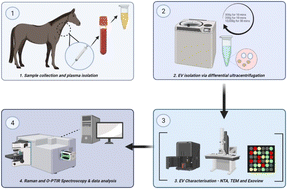Optical photothermal infrared spectroscopy can differentiate equine osteoarthritic plasma extracellular vesicles from healthy controls
Abstract
Equine osteoarthritis is a chronic degenerative disease of the articular joint, characterised by cartilage degradation resulting in pain and reduced mobility and thus is a prominent equine welfare concern. Diagnosis is usually at a late stage through clinical examination and radiographic imaging, whilst treatment is symptomatic not curative. Extracellular vesicles are nanoparticles that are involved in intercellular communication. The objective of this study was to investigate the feasibility of Raman and Optical Photothermal Infrared Spectroscopies to detect osteoarthritis using plasma-derived extracellular vesicles, specifically differentiating extracellular vesicles in diseased and healthy controls within the parameters of the techniques used. Plasma samples were derived from thoroughbred racehorses. A total of 14 samples were selected (control; n = 6 and diseased; n = 8). Extracellular vesicles were isolated using differential ultracentrifugation and characterised using nanoparticle tracking analysis, transmission electron microscopy, and human tetraspanin chips. Samples were then analysed using combined Raman and Optical Photothermal Infrared Spectroscopies. Infrared spectra were collected between 950–1800 cm−1. Raman spectra had bands between the wavelengths of 900–1800 cm−1 analysed. Spectral data for both Raman and Optical Photothermal Infrared Spectroscopy were used to generate clustering via principal components analysis and classification models were generated using partial least squared discriminant analysis in order to characterize the techniques' ability to distinguish diseased samples. Optical Photothermal Infrared Spectroscopy could differentiate osteoarthritic extracellular vesicles from healthy with good classification (93.4% correct classification rate) whereas Raman displayed poor classification (correct classification rate = −64.3%). Inspection of the infrared spectra indicated that plasma-derived extracellular vesicles from osteoarthritic horses contained increased signal for proteins, lipids and nucleic acids. For the first time we demonstrated the ability to use optical photothermal infrared spectroscopy combined with Raman spectroscopy to interrogate extracellular vesicles and osteoarthritis-related samples. Optical Photothermal Infrared Spectroscopy was superior to Raman in this study, and could distinguish osteoarthritis samples, suggestive of its potential use diagnostically to identify osteoarthritis in equine patients. This study demonstrates the potential of Raman and Optical Photothermal Infrared Spectroscopy to be used as a future diagnostic tool in clinical practice, with the capacity to detect changes in extracellular vesicles from clinically derived samples.



 Please wait while we load your content...
Please wait while we load your content...